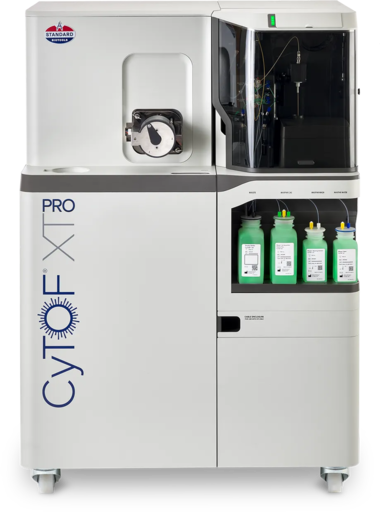Taking on new challenges with a new approach: Get more from precious samples in human challenge studies
Jun Wang, PhD, is a member of the Canadian Center for Vaccinology (CCfV) and a professor of the Department Microbiology & Immunology and Pediatrics at Dalhousie University. Wang and a team of scientists at CCfV are working to establish a controlled human infection model (CHIM) to investigate the host responses to Bordetella pertussis challenge in healthy adult volunteers who received pertussis vaccination during their childhood.

Leveraging Standard BioTools Services Labs for standardized immune profiling in vaccine efficacy studies
Take a challenge for what it’s worth – and in human challenge trials, the value is high. Conducting vaccine trials is extremely important to evaluate and confirm the safety and efficacy of a new vaccine. And while these studies provide meaningful information about the type of immune response that occurs upon vaccination and the dosage levels needed to elicit a response, they sometimes cannot answer targeted questions about disease progression and fading immunity.
Human challenge trials, or controlled human infection models, provide an extra layer of information that can help researchers learn more about the interactions between the immune system, a disease and a candidate vaccine.
Jun Wang, PhD, is a member of the Canadian Center for Vaccinology (CCfV) and a professor of the Department Microbiology & Immunology and Pediatrics at Dalhousie University. Wang and a team of scientists at CCfV are working to establish a controlled human infection model (CHIM) to investigate the host responses to Bordetella pertussis challenge in healthy adult volunteers who received pertussis vaccination during their childhood.
Pertussis, or whooping cough, is highly contagious, with 20–40 million cases reported globally each year. The illness can range from mild in adults and some children to severe and even deadly in younger unvaccinated children and infants. If immunity in vaccinated adults fades, they are prone to infection and potential transmission to vulnerable contacts.

Microscopic visualization of whooping cough bacteria Bordetella pertussis
The goal of the challenge is to identify a measurable immune response to vaccination that is predictive of protection from infection and disease – a first step to developing a more effective and long-lasting vaccine. By identifying this type of surrogate protective immunity against B. pertussis, the team can better understand how pertussis establishes an infection, which disease-causing antigens are the most effective targets for vaccines and what type of immune responses are needed to protect different age populations.
“The reason we chose this type of study is because it is important to look into the immune responses to infection in the most comprehensive way and in a controlled environment,” explains Wang. “These studies are not easy to conduct since all the volunteers need to be hospitalized for a period of time, depending on the outcome of infection. The cost of the study itself is very high, and the samples are very precious.”
Setting up a CHIM for success
Human challenge trials are held to the highest ethical and safety standards and may only be performed if the targeted infection has a rapid onset, can be easily detected and can be treated to prevent significant illness. For this challenge, volunteers were admitted to a Level III human challenge unit at the IWK Health Centre and monitored daily for three weeks followed by outpatient visits for one year. Samples were collected before the infection and at various time points after infection for high-dimensional immune profiling.
Typical analysis for challenge trials employs single-cell RNA sequencing and fluorescence cytometric methods to characterize and compare immune profiles before and after infection. However, these methods can be difficult to work with. When using fluorescence flow cytometry, initial panel development and optimization, which includes titration of each fluorescent marker, are critical to ensure fluorophore compatibility and acceptable signal resolution but can take a lot of upfront work and monetary investment prior to the start of the study.
“When teams get comfortable with a technology like flow cytometry, they forget that it costs a lot of money to build up a flow panel, and it costs a lot to do a site validation … so they don’t consider making a shift until preparation is underway.”
- Jun Wang, PhD
Additionally, fluorescence-based methods can be limited in the number of parameters one can use in a single panel, with the need to balance time spent building and optimizing panels with the desired data output.
Wang saw an opportunity to try the CyTOF™ based Maxpar™ Direct Immune Profiling Assay through a local grant offering from the Standard BioTools™ Services Labs. With the ability to measure a multitude of parameters at once and thereby obtaining 37 immune cell types from a single run, CyTOF technology can be very beneficial for human challenge trials given the smaller sample sizes for these studies. The Maxpar Direct Immune Profiling Assay also would save the team time in study preparation since the kit is validated, standardized and does not require titration steps.
Wang notes that “CyTOF technology is an ideal platform for this and future studies given the limited amount of sample we have. The Maxpar Direct Immune Profiling Assay provides the possibility to look at multiple different immune subsets, including both innate and adaptive immune responses.”

After applying for and awarded the grant, Wang and her team decided to run frozen PBMC samples collected from four volunteers (two symptomatic and two asymptomatic following infection) at baseline (Day –1) and the days post-infection (Days 1, 3, 5 and 14). While the validated, dry-format 30-marker Maxpar Direct Immune Profiling Assay panel covers major circulating immune cell populations, Wang was interested in adding additional markers using the Standard BioTools Expansion Panels designed to enable deeper profiling and functional characterization of specific immune cell subsets relevant in immune-mediated disease. She worked with the Services Lab team to create a 40-marker myeloid and lymphoid activation panel and a 43-marker T cell activation panel that could better examine the kinetics of immune subsets in host responses to B. pertussis infection.
Data from this first study will help determine the amount of B. pertussis a patient can be infected with to result in mild symptoms. Further analysis is aimed at understanding how the disease develops and the details of immune response to the infection. Successful completion of these studies provides valuable information to support safe and effective development of improved vaccines to better prevent the transmission of disease.
Wang and the CCfV team are happy with the results they obtained from the CyTOF data and the experience working with the Services Labs. “The Standard BioTools Services Lab and their wonderful group of people are very helpful in terms of getting our samples run and flexibility in timing and teaching us how to look at the data analysis. Their team is excellent,” she says.
With one challenge study finished and samples banked, the team is working through analysis and has additional challenge studies planned. Wang is working to incorporate the Maxpar Direct Immune Profiling Assay into future studies because of its easy-to-implement format for immunophenotyping.
Depending on the study, the team services samples from a single center or multiple centers. “This particular study is a single-center study, but a planned flu challenge will be from two different centers,” Wang said.
“Since Maxpar Direct Immune Profiling Assay kits don’t involve titration and are ready to use, the technology is preferred when running studies across different or multiple centers, because the reagent itself has been standardized.”
- Jun Wang, PhD
A future for CyTOF in challenges trials
Because human challenge studies focus on understanding host-pathogen interactions and finding correlates of protection, the high coverage that CyTOF technology provides can be incredibly valuable, and the efficiency, speed and simplicity of the Maxpar Direct Immune Profiling Assay offers an accelerated timeline with more detailed data on cells and their functions for any phase of trials, from preclinical work to patient stratification.
“I do see a great possibility for using CyTOF technology in human challenge studies since these types of studies are used for understanding immune responses to the particular infection, and CyTOF will be useful for that,” says Wang.
Ultimately, being awarded the SBI Services Labs grant paid off for Wang. “I have to say I really like the Maxpar Direct Immune Profiling Assay kit. The part I like most is that the reagents have been titrated and are ready to use. That's such an attractive aspect of the technology, that and the standardization of the assay.”
If you are interested in trialing or incorporating CyTOF technology into your current or upcoming study, the Standard BioTools Services Labs can consult in project planning, support pilot studies or run full sample sets including analysis.
This CCfV study is sponsored by the NIH and CDC.
For Research Use Only. Not for use in diagnostic procedures. Patent and License Information: www.standardbio.com/legal/notices. Trademarks: www.standardbio.com/legal/trademarks. Any other trademarks are the sole property of their respective owners. ©2025 Standard BioTools Inc. All rights reserved.
